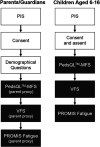Exploring listening-related fatigue in children with and without hearing loss using self-report and parent-proxy measures
- PMID: 36925665
- PMCID: PMC10011639
- DOI: 10.3389/fped.2023.1127578
Exploring listening-related fatigue in children with and without hearing loss using self-report and parent-proxy measures
Abstract
Children with hearing loss appear to experience greater fatigue than children with normal hearing (CNH). Listening-related fatigue is often associated with an increase in effortful listening or difficulty in listening situations. This has been observed in children with bilateral hearing loss (CBHL) and, more recently, in children with unilateral hearing loss (CUHL). Available tools for measuring fatigue in children include general fatigue questionnaires such as the child self-report and parent-proxy versions of the PedsQLTM-Multidimensional Fatigue Scale (MFS) and the PROMIS Fatigue Scale. Recently, the Vanderbilt Fatigue Scale (VFS-C: child self-report; VFS-P: parent-proxy report) was introduced with a specific focus on listening-related fatigue. The aims of this study were to compare fatigue levels experienced by CNH, CUHL and CBHL using both generic and listening-specific fatigue measures and compare outcomes from the child self-report and parent-proxy reports. Eighty children aged 6-16 years (32 CNH, 19 CUHL, 29 CBHL), and ninety-nine parents/guardians (39 parents to CNH, 23 parents to CUHL, 37 parents to CBHL), completed the above fatigue questionnaires online. Kruskal-Wallis H tests were performed to compare fatigue levels between the CNH, CUHL and CBHL. To determine the agreement between parent-proxy and child self-report measures, Bland-Altman 95% limits of agreement were performed. All child self-report fatigue measures indicated that CBHL experience greater fatigue than CNH. Only the listening-specific tool (VFS-C) was sufficiently able to show greater fatigue in CUHL than in CNH. Similarly, all parent-proxy measures of fatigue indicated that CBHL experience significantly greater fatigue than CNH. The VFS-P and the PROMIS Fatigue Parent-Proxy also showed greater fatigue in CUHL than in CNH. Agreement between the parent-proxy and child self-report measures were found within the PedsQL-MFS and the PROMIS Fatigue Scale. Our results suggest that CBHL experience greater levels of daily-life fatigue compared to CNH. CUHL also appear to experience more fatigue than CNH, and listening-specific measures of fatigue may be better able to detect this effect. Further research is needed to understand the bases of fatigue in these populations and to clarify whether fatigue experienced by CBHL and CUHL is comparable in nature and degree.
Keywords: children; fatigue; hearing loss; quality of life; self-report; unilateral hearing loss.
© 2023 Adams, Thornton, Naylor, Spriggs, Wiggins and Kitterick.
Conflict of interest statement
The authors declare that the research was conducted in the absence of any commercial or financial relationships that could be construed as a potential conflict of interest.
Figures




References
-
- Bess FH, Hornsby BWY. The Complexities of Fatigue in Children with Hearing Loss. Perspectives on Hearing and Hearing Disorders in Childhood. (2014) 24(2):25–39. 10.1044/hhdc24.2.25 - DOI
LinkOut - more resources
Full Text Sources

